Nowadays, the desire to rejuvenate the skin and maintain youthful beauty has become a trend among many women. Among the aesthetic solutions gaining attention today, facelift surgery is a popular and effective choice. So, what is a facelift, and is it the right solution for you? Let’s explore this article to find the answer and gain a comprehensive understanding of facelift procedures.
What is a facelift (rhytidectomy)?
A facelift is a cosmetic procedure designed to improve signs of aging on the face, such as wrinkles, sagging skin, and loss of elasticity. After a facelift, collagen is regenerated, helping your skin look younger, firmer, and more elastic for a long period of time.
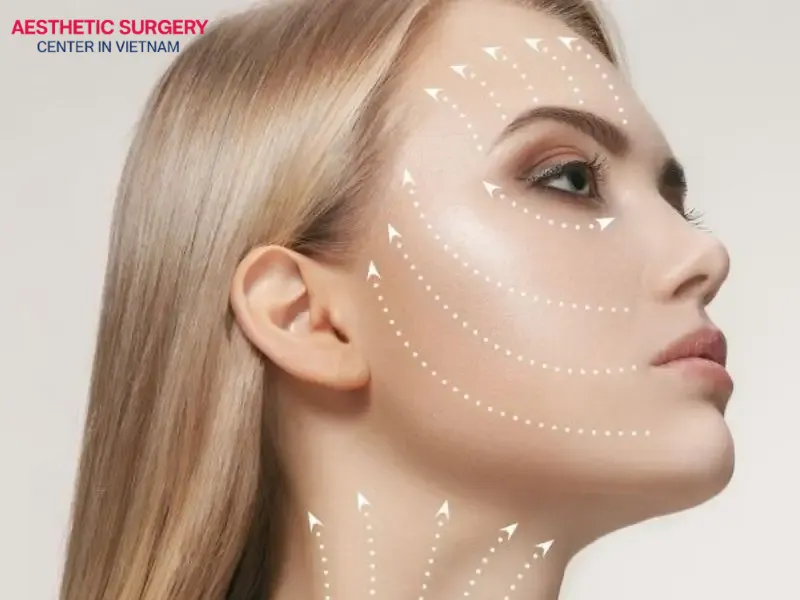
The effects of facelift surgery can be noticeable right after recovery, but the extent and duration of results depend on many factors such as age, individual body condition, surgical technique, and post-operative care. Therefore, a facelift does not provide permanent results, and it should be combined with a proper skincare routine to maintain long-lasting outcomes.
What are the benefits of facelift (rhytidectomy) surgery?
Facelift is a skin improvement procedure chosen by many women because of its effective results. Here are some of the outstanding benefits to give you a clearer understanding before deciding on the procedure:
Reduces wrinkles and fine lines
One of the most notable benefits of a facelift is its ability to significantly reduce wrinkles, especially on the forehead, around the eyes, smile lines, cheeks, and under the chin. As the skin ages, collagen and elastin decrease, leading to a loss of elasticity and the formation of deep wrinkles. Facelift surgery helps tighten the underlying tissues, smooth out folds, and restore a smoother, firmer skin surface.
Improves skin structure
A facelift not only tightens the skin surface but also helps restructure the supporting tissue layers beneath. During the procedure, the superficial muscular layers are repositioned, which stabilizes and firms up the skin structure. This effect is especially noticeable in people with sagging skin, multiple wrinkles, or loss of soft tissue volume due to aging.

Defines facial contours
A facelift is an ideal choice for those who want to restore balanced facial proportions without undergoing overly invasive cosmetic surgery. Thanks to modern techniques, a facelift not only tightens the skin but also makes the overall face appear more youthful and harmoniously proportioned.
Boosts confidence
Skin aging not only affects appearance but also has a significant impact on psychology, especially self-confidence in communication and work. A facelift helps you feel more satisfied with your appearance, enabling you to be more confident and full of positive energy in life.
What are the different kinds of facelifts?
Currently, there are many kinds of facelifts to improve skin aging, but below are the most popular procedures chosen by many women.
Endoscopic facelift
An endoscopic facelift is an advanced cosmetic surgery procedure that uses an endoscopic camera system combined with AI technology to accurately identify the aging muscle groups beneath the skin. Once the target areas are identified, the surgeon tightens the muscles and removes excess fat and sagging skin through tiny incisions cleverly hidden in the hairline or behind the ears. This method is minimally invasive, causes little tissue damage, leaves minimal scarring, and allows for quick recovery.
Advantages:
- Slows down facial skin aging.
- Removes wrinkles and double chin, lifts sagging muscles.
- Defines facial contours, creating a slimmer, more refined appearance.
- Quick procedure time, fast recovery, minimal pain, and no visible scarring.
Note: This method is only suitable for those with good general health, and is not recommended for people with underlying conditions such as diabetes, blood clotting disorders, or high blood pressure.
Collagen thread lift
A collagen thread lift is a nonsurgical skin rejuvenation method that uses biodegradable collagen threads inserted under the dermis. These threads have tiny barbs or hooks that anchor into the skin tissues and facial muscles, forming a supportive mesh that lifts sagging skin and redefines facial contours.
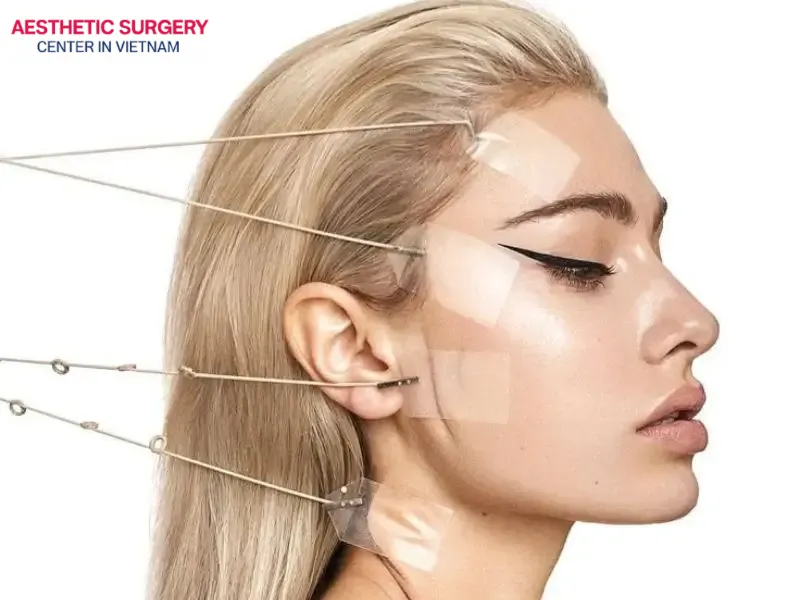
Advantages:
- Improves sagging skin, wrinkles, and drooping in the jawline, cheeks, and temples.
- Enhances skin elasticity by stimulating natural collagen production.
- Painless, no scarring, and no long recovery time needed.
- Visible aesthetic results after 1–2 weeks, with a naturally youthful and slimmer face.
Note: The duration of results is relatively short, usually 1–3 years, depending on individual condition and thread quality. Therefore, this method is not suitable for severe aging or deeply sagging skin.
Mini facelift
A mini facelift is a minimally invasive surgical procedure, often applied to individuals with mild signs of aging in the lower face, cheeks, and neck. This procedure involves making a short incision of about 5–6 cm from the hairline to behind the ear, after which the surgeon removes excess skin and gently tightens the underlying muscle layer, helping to lift sagging skin and enhance facial contours.
Advantages:
- Effectively improves mild sagging and wrinkling in the cheeks and jawline areas.
- Painless, no complications, and does not affect overall health.
- Quick recovery time, no long downtime required.
- Results can last 5–10 years with proper skincare.
Note: This method is not suitable for individuals with moderate to severe aging. Regular follow-up appointments with your doctor are needed to evaluate effectiveness and receive advice on post-operative care.
Who gets facelifts?
Facelift is an effective aesthetic solution, but it is not suitable for everyone. According to cosmetic surgery experts, the best candidates for a facelift are:
- Individuals with clear signs of aging on the face or neck, such as sagging skin and deep wrinkles, but who still maintain a certain degree of natural skin elasticity.
- People with well-defined and harmonious facial bone structure, as this makes it easier to reshape facial contours after lifting, resulting in a natural and balanced look.
- Those aged 35–60 years old, who are beginning to show moderate signs of aging such as mild skin laxity, double chin, and deep nasolabial folds, are often indicated for this procedure.
- Candidates must not have serious underlying health conditions such as uncontrolled diabetes, high blood pressure, or cardiovascular diseases.
- Individuals with realistic expectations, understanding that a facelift cannot completely stop the aging process but can significantly improve and maintain a youthful appearance for a certain period.
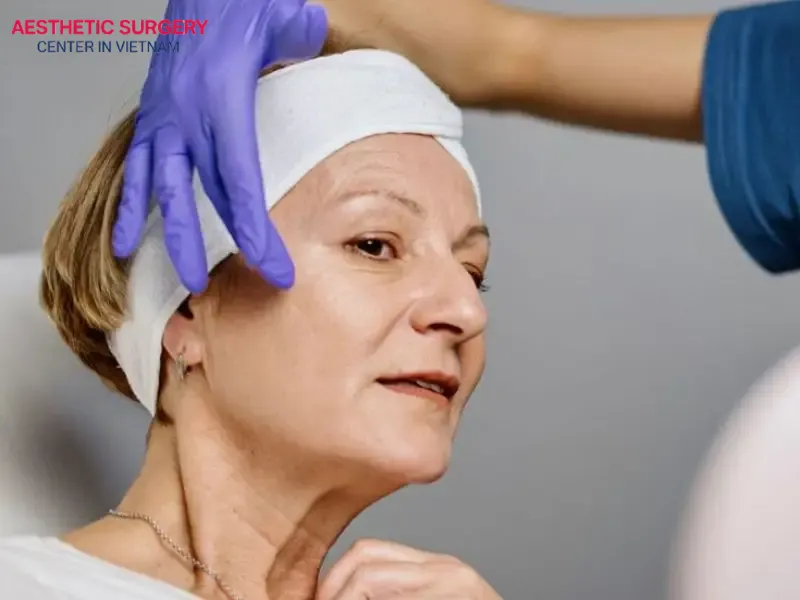
How do I prepare for facelift (rhytidectomy) surgery?
Before undergoing facelift surgery, you will need to have a direct consultation with a cosmetic surgeon to thoroughly assess your health and aesthetic expectations. This consultation includes several important steps to ensure safety and effectiveness during the procedure. Specifically, these steps are:
General examination: The doctor will ask detailed questions about your current health condition, medical history, and any previous surgeries you have had. You should also inform your doctor if you smoke, drink alcohol, or use stimulants, as these factors can affect anesthesia, wound healing, and post-operative recovery.
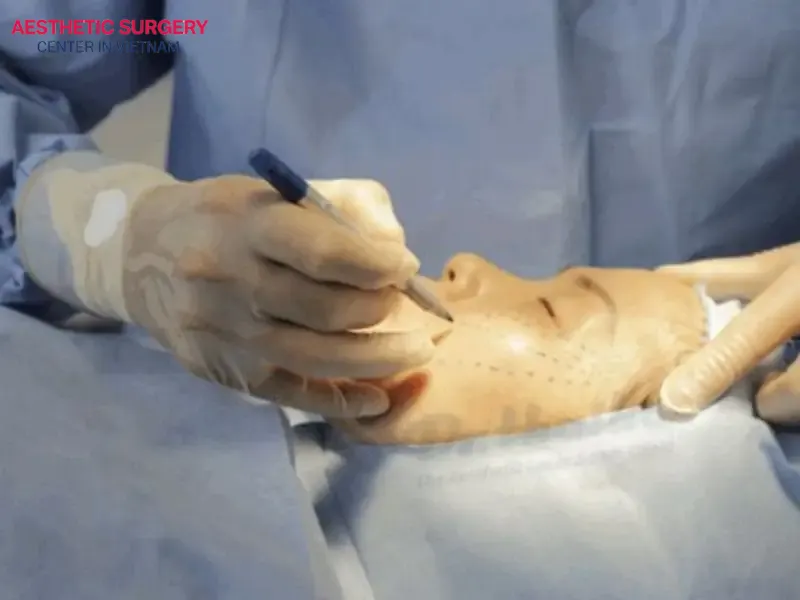
Informing your doctor about current medications: You need to provide a complete list of medications you are taking, as some medications must be stopped at least 2 weeks before surgery to reduce the risk of bleeding and complications.
Facial structure assessment: The doctor will conduct an in-depth examination of your face, including bone structure, subcutaneous fat distribution, skin elasticity, and the degree of sagging.
Discussing expectations: You will receive detailed counseling about the expected results and the limitations of facelift surgery. The doctor will explain that this method cannot completely eliminate fine lines or correct asymmetrical facial shapes.
Pre-surgery instructions: Follow instructions such as fasting after dinner the night before surgery. In addition, you should wash your face and hair with an antiseptic solution on the morning of surgery.
Proper preparation before a facelift not only ensures a smooth surgical procedure but also contributes to optimal aesthetic results and significantly shortens recovery time.
What happens in a facelift surgery?
Before the procedure
Before the procedure, the doctor will perform a pre-anesthesia assessment and administer appropriate anesthesia based on your health condition and the extent of the procedure. There are two main anesthesia methods commonly used in facelift surgery:
- Local anesthesia combined with sedation: Applied for minor procedures or mild facelifts. The patient remains awake but in a deeply relaxed state, and the facial area is numbed locally, so there is no pain during the procedure.
- General anesthesia: Indicated for full facelift surgeries. The patient is put into a deep sleep state and is unconscious throughout the entire surgery.
Choosing the right type of anesthesia is a crucial factor in ensuring the facelift procedure goes smoothly and is pain-free for you.
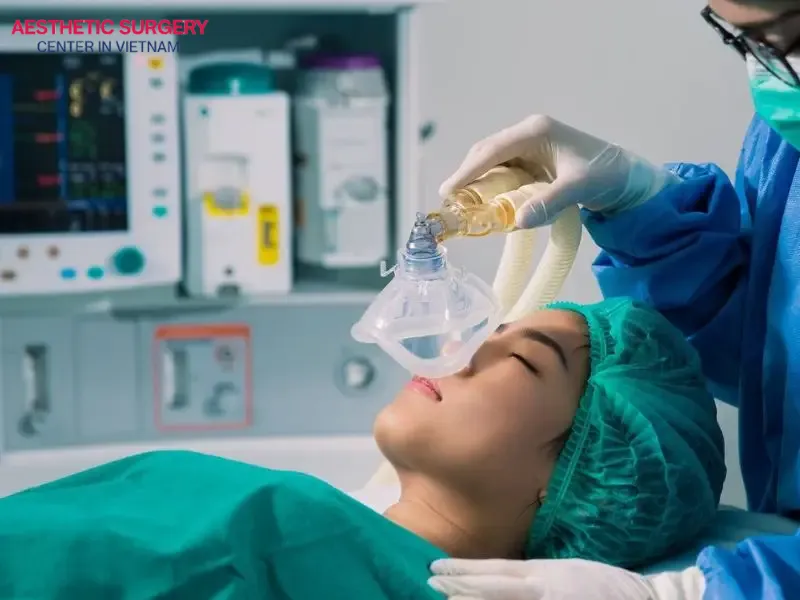
During the procedure
After anesthesia or sedation has been administered, the doctor will perform the standard medical facelift procedure as follows:
Step 1: Creating the incision:
The location and size of the incision will vary depending on the facelift procedure chosen. Some common incision sites include:
- Along the hairline at the temples
- Around the ears
- Behind the neck (lower hairline area)
- Under the chin (for neck lift)
- Inside the mouth (in cases combined with cheek lift)
Usually, before the procedure, the doctor will discuss in detail with you about the scope, location of the incision, and level of invasiveness.
Step 2: Performing the lift:
The doctor will lift the skin and soft tissues, then reposition or remove excess subcutaneous fat, and tighten the muscle layer to enhance firmness.
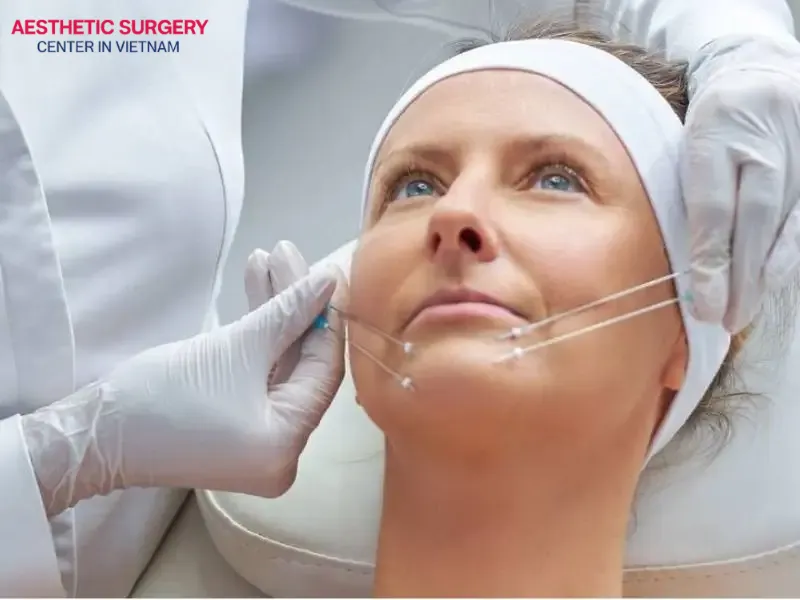
Step 3: Closing the incision:
After completing the internal procedures, the doctor will close the incision with dissolvable sutures, stitches that require removal after a few days, or use surgical glue to support faster healing and minimize scarring.
After the procedure
Once the surgery is complete, you will be transferred to a recovery room, where the medical team will closely monitor you until you are fully awake. At this time, a compression bandage will be wrapped around your face to reduce bruising, swelling, and to help the skin adhere to its new structure. In some cases, the doctor may place a small drainage tube to remove fluid. Before being discharged, you will receive detailed wound care instructions, a follow-up schedule, and pain medication prescriptions if necessary.
Post-facelift care
After a facelift, the post-operative phase plays a decisive role in aesthetic results and recovery speed. Proper care not only helps wounds heal faster and reduces complications but also optimizes rejuvenation effects.
- In the first few days, absolutely avoid scratching or applying force to the surgical area, as this can cause bruising, subcutaneous bleeding, or displacement of newly adjusted tissues.
- Avoid movements that increase intracranial pressure, such as bending the head too low, using high pillows, straining, or vomiting, as these actions can tear tissues or rupture internal sutures.
- Do not laugh loudly, open your mouth wide, or talk excessively for the first 5–7 days to prevent stretching tissues and affecting healing incisions.
- Take medications exactly as prescribed, and do not stop or change medications without your doctor’s approval.
- Change dressings and attend follow-up appointments as scheduled; the first dressing change is usually after 24 hours.
- Apply cold compresses continuously to the surgical area for the first 48 hours to reduce swelling. Avoid placing ice directly on the skin to prevent cold burns.
- If the surgery involves the mouth or jaw area, rinse your mouth every 2 hours with antiseptic solution.
- To prevent bad scarring and wound irritation, strictly avoid foods that can cause inflammation or keloids, such as water spinach, chicken, seafood, glutinous rice, eggs, beef, and spicy foods.
- Do not steam your face, take hot baths, or expose yourself to high temperatures for 4 weeks after surgery.

Aesthetic Surgery Center – A reputable facelift destination in Vietnam
If you are looking for a trusted, safe, and effective facelift center in Vietnam, Aesthetic Surgery Center is an excellent choice. This is a reliable facility trusted by both domestic and international clients. With a team of highly experienced cosmetic surgeons, modern international standard equipment, and a comprehensive post-operative care process, Aesthetic Surgery Center has affirmed its position in the field of facial rejuvenation and aesthetics.
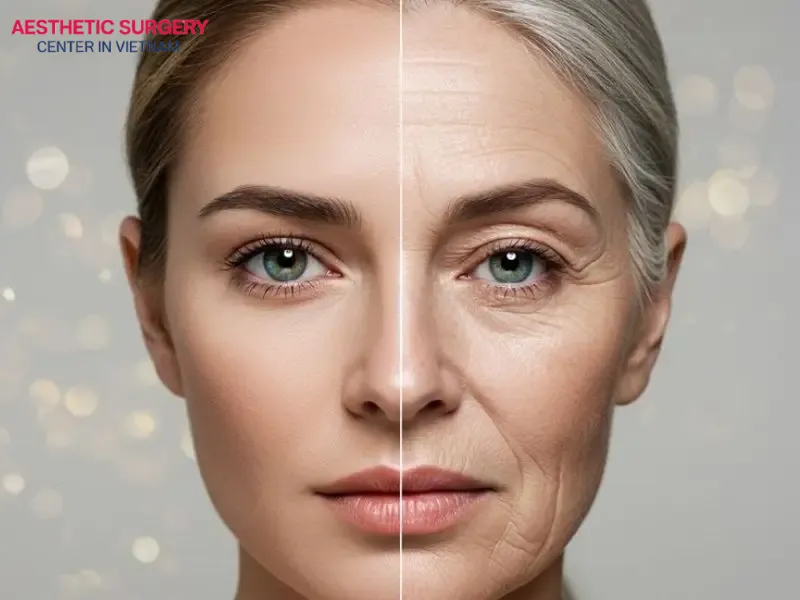
The center features FDA-standard sterile operating rooms, advanced facelift technologies, and personalized solutions, designing individualized facelift plans for each client based on aging condition, bone structure, and skin elasticity.
It is also a favorite destination among clients thanks to its dedicated and specialized post-operative care services, including detailed recovery guidance, surgical wound monitoring, and adjustments after facelift surgery to ensure optimal and long-lasting results. Each client is personally monitored and supported by their doctor throughout the entire recovery process.
All doctors at Aesthetic Surgery Center hold specialized cosmetic and reconstructive surgery licenses and have successfully performed numerous facelift surgeries. With solid expertise and years of experience, the doctors here deliver youthful, natural beauty tailored to each client’s facial features.
Through this article, you now have a clearer understanding of what a facelift is and the popular facelift procedures available today, enabling you to make the right choice to significantly improve signs of skin aging, such as sagging, wrinkles, and laxity. If you are looking for a solution to make your face look younger, more harmonious, and natural, then facelift surgery at Aesthetic Surgery Center is a choice worth considering. For consultations and to experience services at Aesthetic Surgery Center, please contact the hotline: 0911 582 499.







Comment on the post